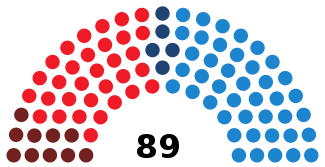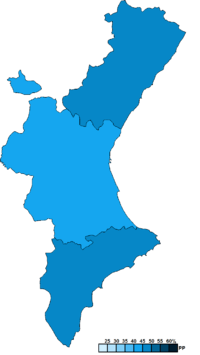Valencian regional election, 1995
| |||||||||||||||||||||||||||||||||||||||||||||||||||||||||||||||||||||||||||||||||||||||||
All 89 seats in the Corts Valencianes 45 seats needed for a majority | |||||||||||||||||||||||||||||||||||||||||||||||||||||||||||||||||||||||||||||||||||||||||
| Opinion polls | |||||||||||||||||||||||||||||||||||||||||||||||||||||||||||||||||||||||||||||||||||||||||
| Registered |
3,131,191 | ||||||||||||||||||||||||||||||||||||||||||||||||||||||||||||||||||||||||||||||||||||||||
| Turnout |
2,380,614 (76.0%) | ||||||||||||||||||||||||||||||||||||||||||||||||||||||||||||||||||||||||||||||||||||||||
| |||||||||||||||||||||||||||||||||||||||||||||||||||||||||||||||||||||||||||||||||||||||||
|
Constituency results map for the Corts Valencianes | |||||||||||||||||||||||||||||||||||||||||||||||||||||||||||||||||||||||||||||||||||||||||
| |||||||||||||||||||||||||||||||||||||||||||||||||||||||||||||||||||||||||||||||||||||||||
The 1995 Valencian regional election was held on Sunday, 28 May 1995, to elect the 4th Corts of the Valencian Community. All 89 seats in the Corts were up for election. The election was held simultaneously with regional elections in 12 other autonomous communities and local elections all throughout Spain.
As a result of the election, the People's Party (PP) increased its vote share by 15 percentage points relative to the 1991 Courts elections. For the first time, the PP had won a regional election, becoming the first party to poll more than 1 million votes in the area and gaining eleven seats, 3 short of an absolute majority. Most of the gains came from Spanish Socialist Workers' Party (PSOE), which lost 13 seats in the election. The regionalist Valencian Union (UV) also lost 1 seat, while United Left (IU) gained 4 seats to overtake UV as the third largest party.
A coalition agreement between the PP and UV was able to force the PSOE out from the Valencian Government after 12 years of Socialist rule. Eduardo Zaplana, the People's Party's candidate, became the second democratically elected President of the autonomous community
Electoral system
The 89 members of the Corts Valencianes were elected using the D'Hondt method and a closed list proportional representation, with a threshold of 5 per 100 of valid votes—which included blank ballots—being applied regionally. Parties not reaching the threshold were not taken into consideration for seat distribution. Seats were allocated to constituencies, corresponding to the provinces of Alicante, Castellón and Valencia. Each constituency was entitled to an initial minimum of 20 seats, with the remaining 29 allocated among the constituencies in proportion to their populations.[1][2] Voting was on the basis of universal suffrage, with all nationals over eighteen, registered in the Valencian Community and in full enjoyment of all political rights entitled to vote.
The electoral law provided that parties, federations, coalitions and groupings of electors were allowed to present lists of candidates. However, groupings of electors were required to secure at least the signature of 1 per 100 of the electors entered in electoral register of the constituency for which they were seeking election. Electors were barred from signing for more than one list of candidates. Concurrently, parties and federations intending to enter in coalition to take part jointly at an election were required to inform the relevant Electoral Commission within ten days from the election call.[1][3][4]
Elections were fixed for the fourth Sunday of May every four years.[2][3]
Background
After 12 years of consecutive Socialist governments both in the Spanish national government and in the Valencian Community, the People's Party (PP) had managed to greatly increase its support from 1992–93, mostly at the cost of what remained of the Democratic and Social Centre (CDS). In the 1993 general election, the PP had already increased its vote share from 27.0% in 1989 to 40.5% and had overtaken the Spanish Socialist Workers' Party (PSOE) in the region for the first time. The party had also seen a dramatical rise in the 1994 European Parliament election, rising to 44.2% from 22.8% in 1989.
United Left (IU) had gained ground at the expense of the PSOE and in both the 1993 general and 1994 EP elections had polled more than 10% for the first time since the 1970s. After peaking in the 1991 Courts and local elections, the right-wing regional party Valencian Union (UV) had begun to lose ground in the 1993 and 1994 elections.
Population's weariness of PSOE's prolonged stay in power, economic crisis as well as the eruption of numerous corruption scandals at the national level had weakened the PSOE in the region to the point it was facing the possibility of a severe defeat for the first time in a decade. Joan Lerma's management of a wildfire crisis in the summer of 1994 came under heavy criticism, after the fire had resulted in the burning of 16% of the region's forest area.[5]
Opinion polls
Individual poll results are listed in the table below in reverse chronological order, showing the most recent first, and using the date the survey's fieldwork was done, as opposed to the date of publication. If that date is unknown, the date of publication is given instead. The highest percentage figure in each polling survey is displayed with its background shaded in the leading party's colour. In the instance of a tie, the figures with the highest percentages are shaded. in the case of seat projections, they are displayed in bold and in a different font. The lead column on the right shows the percentage-point difference between the two parties with the highest figures. 45 seats were required for an absolute majority in the Corts Valencianes.
| Polling firm/Commissioner | Fieldwork date | Sample size | Turnout | |
|
|
|
Lead | |
|---|---|---|---|---|---|---|---|---|---|
| 1995 regional election | 28 May 1995 | N/A | 76.0 | 34.0 32 |
42.8 42 |
7.0 5 |
11.5 10 |
8.8 | |
| Emer–GfK/Levante-EMV[p 1] | 21 May 1995 | ? | ? | ? 32/34 |
? 42/45 |
? 0/4 |
? 10/11 |
? | |
| Gesfono/Las Provincias[p 1] | 10–15 May 1995 | ? | ? | 30.1 28/31 |
46.0 43/46 |
6.0 3/4 |
13.2 11/12 |
15.9 | |
| Demoscopia/El País[p 2][6] | 10–15 May 1995 | ? | ? | 29.1 29 |
44.0 43 |
6.6 6 |
13.3 11 |
14.9 | |
| CIS[p 3][p 4] | 24 Apr–10 May 1995 | 1,598 | 72.3 | 30.7 | 46.5 | 6.7 | 10.9 | 15.8 | |
| Perfiles[p 1] | 7 May 1995 | ? | ? | ? 32/34 |
? 42/45 |
? 0/4 |
? 10/11 |
? | |
| Gesfono/Las Provincias[p 1] | 30 Apr 1995 | ? | ? | 30.1 29/30 |
45.2 43/44 |
6.2 4 |
13.5 12 |
15.1 | |
| 1994 EP election | 12 Jun 1994 | N/A | 65.0 | 30.5 29 |
44.2 45 |
5.3 3 |
13.9 12 |
13.7 | |
| 1993 general election | 6 Jun 1993 | N/A | 81.7 | 38.4 39 |
40.5 41 |
4.6 0 |
10.5 9 |
2.1 | |
| 1991 regional election | 26 May 1991 | N/A | 69.2 | 42.8 45 |
27.8 31 |
10.4 7 |
7.5 6 |
15.0 | |
Results
Overall
 | ||||||
| Parties and coalitions | Popular vote | Seats | ||||
|---|---|---|---|---|---|---|
| Votes | % | ±pp | Won | +/− | ||
| People's Party (PP) | 1,013,859 | 42.83 | +15.01 | 42 | +11 | |
| Spanish Socialist Workers' Party (PSOE) | 804,463 | 33.98 | –8.87 | 32 | –13 | |
| United Left–The Greens (EU–EV)1 | 273,030 | 11.53 | +2.24 | 10 | +4 | |
| Valencian Union–Independents–Centrists (UV–FICVA–CCV) | 165,956 | 7.01 | –3.35 | 5 | –2 | |
| Valencian People's Union–Nationalist Bloc (UPV–BN) | 64,253 | 2.71 | –0.97 | 0 | ±0 | |
| Parties with less than 1.0% of the vote | 20,975 | 0.89 | — | 0 | ±0 | |
|---|---|---|---|---|---|---|
| Democratic and Social Centre (CDS) | 5,480 | 0.23 | –3.58 | 0 | ±0 | |
| Communist Party of the Peoples of Spain (PCPE) | 3,772 | 0.16 | +0.02 | 0 | ±0 | |
| United Alicante (AU) | 2,894 | 0.12 | New | 0 | ±0 | |
| Autonomist Republican Party (PRA) | 2,232 | 0.09 | New | 0 | ±0 | |
| Valencian Nationalist Left (ENV)2 | 1,861 | 0.08 | –0.03 | 0 | ±0 | |
| Spanish Falange of the JONS (FE–JONS) | 1,762 | 0.07 | New | 0 | ±0 | |
| Platform of Independents of Spain (PIE) | 1,659 | 0.07 | New | 0 | ±0 | |
| Humanist Platform (PH–LE) | 773 | 0.03 | New | 0 | ±0 | |
| Spanish Autonomous League (LAE) | 542 | 0.02 | New | 0 | ±0 | |
| Blank ballots | 24,864 | 1.05 | +0.02 | ||||||
| Total | 2,367,400 | 100.00 | 89 | ±0 | |||||
| Valid votes | 2,367,400 | 99.44 | ±0.00 | ||||||
| Invalid votes | 13,214 | 0.56 | ±0.00 | ||||||
| Votes cast / turnout | 2,380,614 | 76.03 | +6.79 | ||||||
| Abstentions | 750,577 | 23.97 | –6.79 | ||||||
| Registered voters | 3,131,191 | ||||||||
| Source(s): Corts Valencianes, historiaelectoral.com, Argos Information Portal | |||||||||
| |||||||||
Distribution by constituency
| Constituency | PP | PSOE | EU–EV | UV–FI–C | ||||
|---|---|---|---|---|---|---|---|---|
| % | S | % | S | % | S | % | S | |
| Alicante | 46.7 | 15 | 36.0 | 12 | 10.9 | 3 | 2.1 | − |
| Castellón | 45.6 | 11 | 35.6 | 8 | 8.2 | 2 | 4.4 | 1 |
| Valencia | 40.1 | 16 | 32.5 | 12 | 12.6 | 5 | 10.3 | 4 |
| Total | 42.8 | 42 | 34.0 | 32 | 11.5 | 10 | 7.0 | 5 |
Opinion poll sources
- 1 2 3 4 "Corts. Anuario de Derecho parlamentario" (PDF). Corts Valencianes (in Spanish). 1996.
- ↑ "El PP será la fuerza más votada en 12 comunidades". El País (in Spanish). 20 May 1995.
- ↑ "Preelectoral Comunidad Valenciana (Estudio nº 2167. Abril-Mayo 1995)". CIS (in Spanish). 10 May 1995.
- ↑ "Estudio CIS nº 2167. Ficha técnica" (PDF). CIS (in Spanish). 10 May 1995.
References
- 1 2 Valencian Electoral Law of 1987, Law No. 2 of March 31, 1987 Official Journal of the Valencian Community (in Spanish). Retrieved on 17 March 2017.
- 1 2 Statute of Autonomy of the Valencian Community of 1982, Organic Law No. 1 of July 1, 1982 Official State Gazette (in Spanish). Retrieved on 17 March 2017.
- 1 2 General Electoral System Organic Law of 1985, Organic Law No. 5 of June 19, 1985 Official State Gazette (in Spanish). Retrieved on 28 December 2016.
- ↑ "Representation of the people Institutional Act". juntaelectoralcentral.es. Central Electoral Commission. Retrieved 16 June 2017.
- ↑ "The summer in which the Community burned" (in Spanish). Las Provincias. 2009-08-10.
- ↑ "El PP gana en doce autonomías y el PSOE sólo en Extremadura, según un sondeo". La Vanguardia (in Spanish). 21 May 1995.
.jpg)

